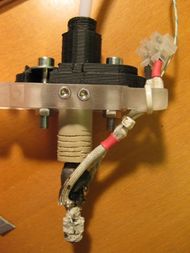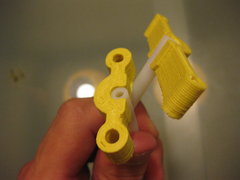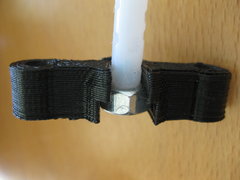Erik's Bowden Extruder
This page is a development stub. Please enhance this page by adding information, cad files, nice big images, and well structured data!
Release status: unknown
| Description | A fast Bowden extruder design
|
| License | unknown
|
| Author | |
| Contributors | |
| Based-on | |
| Categories | |
| CAD Models | |
| External Link |
Contents
Преимущества подачи Боудена
Кабель Боудена позволяет уменьшить массу экструдера и, таким образом позволяя быстрее двигаться каретке, уменьшить тряску вашего принтера, меньше потреблять энергии и, что важно: быстрее печать! Обычно механизм, который продвигает нить в горячую часть (там, где плавится нить) находиться непосредственно на верхней части экструдера. Это создает колебания при быстром движении головки, которые можно увидеть в результатах печати, слышать и чувствовать, когда ваша машина трясется при печати. Если механизм привода нити поместить на неподвижную часть 3D Принтера, ее можно толкать в трубку. Для этого применяют трубку из ПТФЭ (тефлона ™), потому что это скользкая: тефлон имеет меньшее трение с пластиком. Это уменьшает износ и потерю энергии. Другой конец трубки подключают к горячей части экструдера.
Концепцию использования Кабеля Боудена было предложено и впервые Ed Sells. Посмотрите его блог здесь [1]
Преимущества
Чем легче экструдер, тем быстрее вы можете перемещать печатающую головку при печати . Машине будет нужно меньше тока для запуска двигателей. Тем более, это уменьшает массу X-оси, что позволяет проще и легче ее позиционировать. при меньшей массе стальные оси скольжения будут не нужны, что позволяет ближе приблизиться к самовоспроизведению. Сам кабель Боудена может быть напечатан из нескольких модулей, которые соединяются вместе. Проводящий канал может быть облицован тефлоновой лентой -ленты (имеется в каждом магазине), которые могут быть заменены при износе.
Drawback
The Bowden cable system has one major drawback: Hysteresis. The plastic filament will compress in any extruder, but putting pressure on such a long length of filament will multiply the effects of this compression, leading to springiness. The flexibility of the PFTE tube exacerbates this problem.
It is potentially possible to control this problem, perhaps with an encoder just above the hot end. Software might also be able to reduce this problem, but would require (maybe lengthy) calibration.
A stepper-based extruder is required if no encoder is used.
Implementations
Several couplings have been suggested to affix the slippery PTFE at either end:
- Glueing it on, not a very good solution, I found - http://www.thingiverse.com/thing:996
- Threading a nut onto the end, using a printed coupling - http://www.thingiverse.com/thing:1899 (Darwin) http://www.thingiverse.com/thing:2221 (Mendel)
- Push-to-fit coupling, you can push in the PTFE and it will have a pretty tight friction fit - http://www.thingiverse.com/thing:3775
- Removing a 'ring' of PTFE and using a Circlip - http://www.thingiverse.com/image:18270 (by Siert Wijnia)
- The Ultimaker uses push fit couplings at both ends, facilitating rapid switches and easy access. See also ultimaker.com.
From left to right: Snap fit Bowden coupling, Captive nut coupling
Bowden hints and tips
- Gives you slightly less control over how much thermoplastics are output where, but:
- It decouples the extruder drive mechanism from the moving mass in the printer.
- By doing this it greatly reduces the mass, allowing much faster motion and less oscillations at the surface of the objects' exteriors.
- It also allows you to use a decent plastic driving motor or more 'space consuming' complex gearing arrangement. This makes sure that you can not only speed up motion, but also output more plastics. So this is especially a good way towards faster printing.
- It can help make printing slightly more reliable. If the nozzle orifice is jammed for just a short while (e.g. too close to a part of the object that curled up a little bit), without the Bowden extruder the drive mechanism will have stripped the filament and not recover because it loses grip when it has stripped it too much. With the Bowden extruder, short blockages are not causing failure of the build. This is useful when you're just starting with printing, because you may have some problems getting large objects to stick to the platform very well.
- Reversing the extruder motor very quickly allows you to have less oozing. The beneficial effect of reversing is more pronounced for the Bowden cable setups than for regular extruders.
- Fast changes in Z-height are helpful if you don't want to get a small seam where it changes layers. So make sure your bot can go fast in that direction too, or optimize it to have zero oozing.
- The Bowden extruder is not as helpful if you have a fixed printing head (or moving in Z-only) and a XY-moving platform. There are still, however, multiple advantages to be gained even in these cases. By physically separating the extruder from the hot end you eliminate potential physical incompatibilities between the two, it becomes much easier to disassemble and fix either component in the event of failure in one part, and you eliminate the problem of the hot end potentially melting the extruder body.


